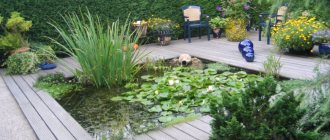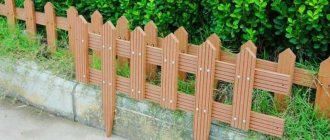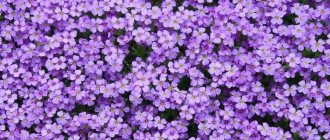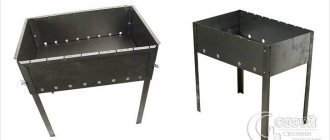History of gravel gardens
In eastern countries, dry gardens or rock gardens date back to the Muromachi period (1336-1573). This is when it becomes popular to decorate areas with gravel and place a decorative object in the center in the form of a fountain, a plant in a flowerpot or a sculpture.
The gravel garden is a kind of offshoot from the famous dry gardens, which has a specific creator. The author of this idea is Beatrice Chatto. She, taking oriental landscapes as a basis, created her first gravel garden in the 70s of the 20th century.
Since then, the style has undergone some changes, which were introduced not only by Beth herself, but also by her followers.
A gravel garden is an original decoration for any estate
All summer residents and owners of personal plots try, to the best of their material and physical strength, to make their plot cozy, comfortable, beautiful, so that the owners can have a pleasant rest, and friends can come to visit with pleasure. In order to decorate the estate, many landscape design ideas are offered: artificial ponds, fountains, lawns, flower beds, alpine slides - you can’t count it all. Some of these projects are expensive, others are too complex, and others require a lot of space. But there is a rather rare type of landscape design in our country that does not require large expenses and is not pretentious to the size and topography of the occupied space. This gravel garden is a real find for the modern summer resident, allowing him to show his imagination and skill.
Gravel has been used in landscaping for many centuries. They covered paths in parks and decorated flower beds. But already in ancient times they began to create gravel landscape compositions. These were mainly areas for games and recreation. They were decorated with sculptures, decorative fountains, benches, and the entire area was covered with fine gravel. It was not only beautiful, but also gave the opportunity to walk outdoors in any weather.
Gravel gardens are especially valued in eastern countries. They are widely used in the design of parks and charming places for recreation and walks.
From the east we came to know about the “dry landscape” - a unique invention of the eastern masters of landscape design. Among its other varieties, Japanese “rock gardens” stand out. These are original compositions made from all kinds of stones, the main accent of which is a platform laid out with gravel in the form of complex patterns of lines and circles that carry their own philosophical meaning.
Looking at these wonderful examples of design art, you will inevitably want to create something similar on your site. Moreover, this requires such an accessible material as gravel.
You can imagine and build the most incredible, amazing, wonderful gravel garden thanks to the large assortment of gravel in size, shape and color that is available for sale. Having united the entire composition with a common design theme, think through all the details that should complement each other, decide what kind of gravel you will use to realize your plan. Then your gravel garden will be a delightful place for you to relax at any time of the day and in any weather.
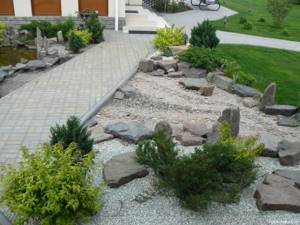
Before purchasing gravel, familiarize yourself with its properties. We want to draw your attention to the main advantages and disadvantages of gravel.
Content
Positive properties of gravel
The most important property is environmental cleanliness
Environmental cleanliness is the main positive property of gravel. Since it is a natural material, gravel does not release any harmful substances into the environment. And even, on the contrary, it has a beneficial effect on the soil on top of which you laid it. Gravel acts as a mulching material - it protects the soil from drying out, forming a dense crust, and temperature changes. Due to its loose structure, the gravel layer freely allows water and air to pass through it to the roots of plants that are planted in the ground under the gravel. If the soil is clayey, then fine gravel, mixing with it, loosens the soil structure, which allows some types of plants to thrive in these conditions.
The defining property of gravel is decorativeness
An equally important positive property of gravel is its decorative effect. By choosing the type of gravel that matches the composition in color and structure, you can create original patterns, highlight beautiful plants, and design decorative areas. The gravel garden is not afraid of any weather conditions; neither rain, nor strong winds, nor hail will damage it. Winter cold also will not affect the gravel garden in any way, which cannot be said about ordinary green spaces, which require special care.
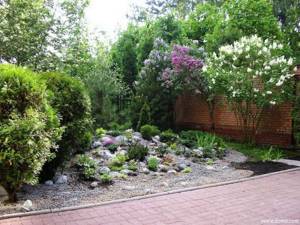
Decorating your patio with beautiful colored gravel is especially necessary if the soil or climate is not suitable for growing rich, lush vegetation. There is no point in tormenting stunted flowers in a dry or swampy area. Instead, create a charming gravel garden that will delight you with its timeless beauty.
Colored gravel is especially decorative. It allows you to show your creative imagination. You can lay out intricate patterns of gravel of different colors, not forgetting natural-colored gravel, which is beautiful in itself.
Gravel of various sizes is decorative in creating a gravel garden composition. A fairly wide range of gravel sizes is available: from 8 to 75 mm. This allows you to designate individual areas of the garden, which increases its decorativeness.
Combination with other materials
A remarkable property inherent in gravel is its surprisingly harmonious compatibility with any materials that are used to decorate garden plots, as well as with all kinds of plants - from small flowers and mosses to trees.
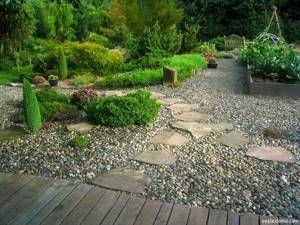
Gravel will help improve empty areas of the estate
In any yard there are places that are unsuitable for growing ornamental plants, creating recreation areas or buildings. These are, as a rule, inconvenient hillocks, ravines, rocky areas that have to be walked around, but there is no benefit from them. But why do we need wastelands if we can create a wonderful picturesque corner in their place? You can plant grass, but it is difficult to maintain if it is a steep slope or hole. But gravel, artistically laid out and complemented with stones, is an excellent solution for decorating difficult areas. This is how elevations above cellars are decorated. It turns out both beautiful and practical, because a layer of gravel protects the soil above the cellar.
If the trees on the site are large and have a wide, dense crown, then usually nothing grows under them, and the land is empty. This is where you can place a wonderful, elegant gravel garden made of light colored gravel, shade-loving plants, mosses, and fancy driftwood. Add colorful mushroom or animal figures. A forest fairy tale in your garden will bring joy to you and your children.
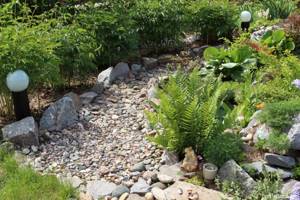
Ease of making and caring for a gravel garden
Even a beginner can work with gravel. The process of laying out a site with gravel is not that complicated; you just need to familiarize yourself with its main stages and feel free to take on the implementation of your idea. The main thing you need is the desire and determination to make your gravel garden a unique work of landscape art. To do this, you have an inexpensive and easy-to-use material - gravel, which you can choose both in size and color. Make interesting compositions from gravel with other materials, lay out ornaments, and add plants that suit your design. The main job is to make a gravel garden, and virtually no maintenance is required since gravel is a very durable material.
Gravel is a convenient material for simulating various natural phenomena
Not every site can have a reservoir - a pond, a lake, a river. Most often due to the small area, although the complexity and cost of equipment for them also matter. From gravel you can create a wonderful imitation of water, which will be an excellent replacement for a pond, and will save you from a lot of hassle associated with its maintenance.
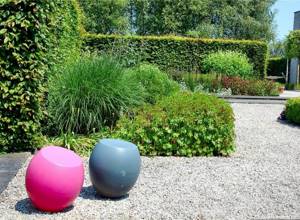
Using gravel, especially when combined with other materials, you can imitate any natural phenomena. The color and size of the gravel will emphasize the similarity of the imitation to the natural environment. For example, fine light yellow gravel imitates the desert; different shades of blue and green gravel in different sizes will create an imitation of the sea.
Negative properties of gravel
After you have become familiar with the main positive properties of gravel, the question naturally arises: what are the negative aspects of this wonderful material? Perhaps you could call it heavy weight. It will take a lot of work to distribute the gravel on the site. But the joy from the created beauty will be much greater than the effort expended.
Using gravel in the garden
As mentioned earlier, you do not need any special knowledge or experience to use gravel for landscaping your garden. Place gravel at the base of trees or other large plants in circles or squares. It would be better if it was colored gravel laid out with an ornament. This way you will create a wonderful garden decoration, while simultaneously protecting the tree roots from drying out. But the pinnacle of your original creativity can be a gravel garden, which we will help you build.
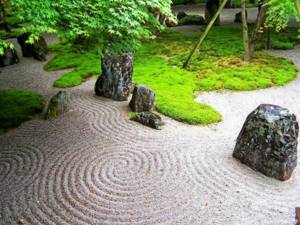
What you need to know to create a gravel garden
Inspect the entire territory of your estate and select a suitable site for your future gravel garden. Clear the entire area of debris, then remove weeds by removing the top layer of soil. The cleared area must be treated with a herbicide that is specially produced for such purposes. After this, make drainage and pour a base, which must be compacted tightly. Lay a geotextile or regular technical film over the base and secure it with wire staples. In this case, the dimensions of the canvas should be slightly larger than the dimensions of the marked area, which makes it possible to attach it. Holes are cut in the canvas into which the plants will be planted.
The types and number of plants must be thought out in advance, although replacements are quite possible in the process of arranging the composition. Plants should be unpretentious and fit well into the overall picture of the garden. Naturally colored gravel goes well with wildflowers, which, moreover, do not require special care.

Overgrown mats of low plants covered with small bright flowers look good. Awl-shaped phloxes, densely covered with colorful flowers, are perfect for this. Various types of sedums are widely used. Their succulent leaves delight the eye throughout the warm season, withstanding even the cold. All types of sedums are showered with bright, colorful flowers, but each of them has its own color. The leaves are also beautiful in their own right, ranging from bright green to purple. This allows you to create interesting colorful compositions from them. Different types of thyme will also make a great addition to your gravel garden with their tall, light pink inflorescences. If steppe motifs are played out in your gravel garden, then the presence of such steppe plants as wormwood, yarrow, and feather grass is simply necessary. Wormwood will fill your summer cottage with a steppe aroma, yarrow will decorate the gravel with soft leaves and white umbrellas of flowers, and feather grass will surround your gravel garden with a fluffy cloud.
Plant ornamental shrubs in your gravel garden as well. Choose low-growing varieties that will have an attractive, fresh look all season long.
Once you have selected and prepared your plants, begin planting them in your gravel area.

How to properly plant plants in a gravel garden
In the place where you want to plant the plant, make a cross-shaped cut in the film. Turn the corners of the film outward. In the resulting square of land, remove the top layer of soil and fill the groove with fertile soil. You can add fertilizer to the soil. We plant the plant by digging in its root system. Once all the plants are planted, begin laying gravel. It must be thoroughly rinsed first, because the gravel may contain not only dust and debris that worsens its appearance, but also weed seeds that you will have to deal with later. Lay gravel in a layer of 5 cm, filling hard-to-reach and distant places first, gradually approaching the exit.
If you're laying out colored gravel for a design or an interesting winding path, you'll need borders. Thanks to the borders, the pattern will not be disrupted along the edges, and the boundaries of the paths and the entire gravel garden will remain on the original line. Curbs are made of plastic or metal, of different heights. You can also make your own border from bricks or boards impregnated with a water-repellent preparation. It is important not to install borders from thin hard materials such as slate, plywood, or sheets of metal. You can get hurt by accidentally stepping on them.

To improve a gravel garden, you can use not only plants and stones, but also various “soft” coverings. They are so called because they consist of small or round granules that are “soft” to step on. Such materials go well with gravel, so it would be a good idea to decorate your gravel garden with a winding “soft” path that will be pleasant to walk on barefoot, especially after rain.
To make such a path, you first need to mark its outline along its entire length. Then dig a fairly deep groove - up to 40 cm within the outlined border. Fill the bottom of the groove with a 15 cm layer of sand and compact it. Make the same layer of ordinary crushed stone on top. Now you can install borders and fill in a 10 cm decorative layer of small colored gravel, pebbles or other material, the granules of which are no larger than 1 cm. Calculate in advance the amount of material required for the decorative layer. If it is fine gravel, then a square meter of a 10 cm layer weighs about 200 kg. After laying the decorative material, completely wet all layers with water and tamp tightly. You now have a walking path.

Let's summarize and evaluate the work done. We examined in detail all the advantages of gravel - an amazing material for arranging a summer cottage or garden plot. Absolutely simple methods of work, without the use of complex devices, with inexpensive materials, and as a result we get a simply delightful result - a charming gravel garden that can be admired all year round.
If, inspired by this article, you decided to create a unique, charming gravel garden on your site with your own hands, share with everyone your experience and ideas on using gravel to decorate your yard.
Other Related Posts:
Advantages of gravel composition
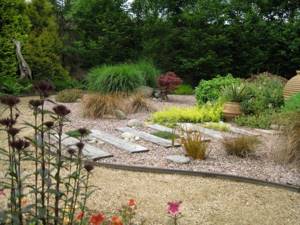
- Decorative. This garden looks spectacular throughout the year. He is not afraid of the vagaries of nature, from which ordinary flower beds can become unusable (for example, drought, cold, heavy rains). It is also easy to disguise elements of the irrigation and lighting system of the site under gravel.
- Economical. Gravel is a relatively inexpensive material. In addition, you can combine it with various pebbles that are already on the site.
- Easy to care for. The most effort required is when creating a gravel garden with your own hands. Then all work is reduced to a minimum, because the plants chosen for this design are unpretentious, no foliage cleaning is required, and the coating itself requires almost no maintenance.
- Versatility. A gravel garden is ideal for all types of plots, especially for very problematic ones, where it is extremely difficult to grow ornamental plants and an emerald lawn. For example, a good solution is to plant a stone flower garden in a shaded place.
- Environmental friendliness. Properly laid gravel allows you to keep the soil cool and optimally moist, thereby maintaining good conditions for the development of the root system of trees and other plants. In addition, a layer of pebbles reduces temperature changes and protects the soil from frost in winter and from overheating in summer.
What it is?

The science of creating gravel gardens lies in the combination of two main elements - a mound of gravel and planted beautiful plants. Colored gravel, crushed stone or pebbles can be used as bulk material. To ensure that the composition of stones does not lose its shape, it is fenced around the perimeter and separated from the paths by low borders, which looks beautiful when placing a section of gravel inside the lawn.
You can fill gardens with colored gravel regardless of the type of soil and the availability of free territory on the site. This type of garden is small in size, from 1 m2.
How to make a gravel garden?
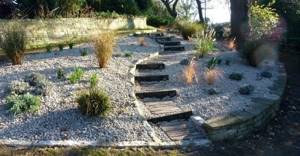
Ease of creation is one of the advantages of landscape decoration with gravel. Anyone can do it at minimal cost.
Step-by-step creation of a gravel garden with your own hands:
- Choosing a location. It is not necessary to cover the entire garden with small pebbles. You can decorate only a small part of it in this way, making a kind of flower bed. The recommended minimum area on which a gravel garden will look impressive is 1-1.5 square meters. m.
- Creating a territory plan on paper or electronically.
- Calculation of materials and their preparation. It is very important to calculate the required volume of gravel. For example, for 12 sq. meters of territory you need approximately one ton of stones.
- Site preparation. At this stage, a whole range of work is carried out: cleaning the site, tilling the soil, digging the soil, and so on.
- Filling with gravel and creating dividing curbs.
- Planting plants.
- Landscape works for garden decoration.
Step-by-step creation of a gravel masterpiece
The work order is as follows:
- The first step is to choose a place where you would like to arrange your garden. If there is not much space on the site, it can be created even on an area of 1-1.5 sq.m.
- We carry out cost calculations and prepare materials.
- After the location has been chosen and the materials have been purchased, you need to prepare the soil. Sandy soil is most convenient for creating such a garden, although it can be done anywhere. The site needs to be marked, indicating its boundaries - drive in pegs, pull the rope. Then a 10-15 cm layer of soil is removed from the ground. Particular attention should be paid to removing weeds along with the roots. Weeds are usually the main problem when maintaining a gravel garden. After the layer of soil and weeds are removed, the pit with moistened soil is left for 7-10 days, during which time the roots of the weeds will grow and they can be completely removed.
- Then the area needs to be dug up , adding raising agents to the soil - vermiculite, expanded clay sand, coarse sand. This way you will drain the soil so that excess moisture is removed from the roots of the plants, which will then be planted in this area. Organic fertilizers and peat can be added to the soil so that the planted plants take root and grow well.
- The soil needs to be compacted a little and covered with geotextiles. Geotextiles will prevent weeds from germinating and also keep the gravel layer from subsiding.
- Now you can fill in the gravel. There are two options here: plant the plants and then fill in a layer of gravel or crushed stone, or first make the backfill and then plant the plants. The first option seems more convenient, although many choose the second option. Garden gravel is not the only material that can be used. Pebbles are also suitable for such a garden; their rounded shape and grayish color will look good against the background of the surrounding lawns. Large stones are not used when creating a gravel garden.
- Creating dividing borders. Borders will help maintain the borders of the garden, otherwise the roots of other plants will eventually penetrate the site, and the gravel border will be washed away by rain.
- Planting plants. If you decide to plant plants after filling with gravel, you need to rake the gravel layer in the designated areas, make a hole in the agrofibre, make a depression, and plant the plant. Then remove unnecessary pieces of agrofibre and carefully level the gravel.
Here's what it all looks like:

This is an example of calculating the costs of constructing a gravel platform; the prices are quite relevant. Most likely you will not have to use geogrids - only if you are doing work on a slope
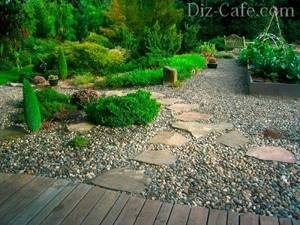
Pebbles are a good choice for a gravel garden. In this case, a stone path is made on top of the main covering and a boardwalk is laid to make it easier to move around the garden.
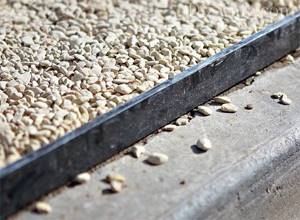
The border can be made of plastic, iron, brick or use a curb stone
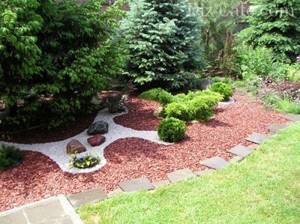
To decorate your garden, you can use either gray or multi-colored gravel. Using two colors to create spectacular patterns
Creating a Sketch
This is the most creative stage, during which the landscape design of the garden plot is completely thought out:
- the relief and pattern of the territory are invented;
- plants are selected and grouped;
- gravel covering is selected;
- are defined with various decorative elements and so on.
The first step in developing a project is to think through the topography of the site. This could be a flat surface, an area with a slight slope, or an area with more difficult transitions in the form of hills. Here it is necessary to start not so much from personal wishes, but from the existing features of the garden and the gravel surface itself. For example, to prevent pebbles from falling off, the maximum permissible slope should not exceed 10 degrees. When laying out a garden on a steeper slope, it is better to resort to creating terraces.
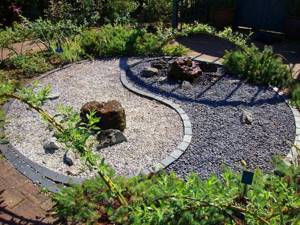
Simultaneously with determining the surface topography, stones and coating patterns are selected. For example, you can combine different materials and create patterns with them, as in the photo above. The simplest, but no less effective design is the use of multi-colored small and large gravel mixtures.
Experience in creating gravel gardens
I am writing based on my own many years of experience. The first sections, small ones, were made more than 10 years ago, the last ones - 3 years. Among them there are those filled with crushed granite, small expanded clay, and some with a small fraction of what is called construction pebbles. Bushes, trees, ground cover grow on them, and summer trees are sown on them. Everything is growing normally, sedum thymes grow better than on the ground. Shrub trees experience the usual garden misfortunes, to the same extent that they occur in all gardens.
Let me start with what a gravel garden does not refer to: in landscape construction, backfill often means a gravel covering, sometimes they say “screening.” This is how paths and platforms are made, such a covering must be hard, even, it is actually paving, fertile soil is removed under it and a whole compacted “pie” of sand and crushed stone is built. The main difference is that nothing is planted on it. My technique refers to a different type of surface; a gravel garden is just that: a garden.
It can contain as much greenery as you want, “in the gravel” (quotes for a reason) you can plant ornamental bushes and trees, deciduous and coniferous, and if you don’t want the effect of dry rockiness, then almost all the gravel can be covered with shrubs and shrubs spreading horizontally with branches cover with “pillows” and “carpets” of ground cover.
This is how the fill becomes overgrown over time:
The section of lawn that was in the top photo to the left of the gravel clearing is now like this:
Selection of plants
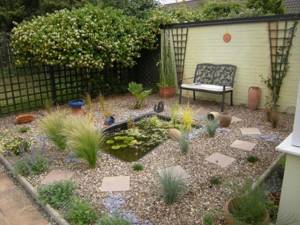
Plants for the garden are selected based on the characteristics of the site and the ability to care for them. For example, there are drought-resistant, unpretentious crops that do not require much attention. Other important rules for selecting plants are the decorativeness of crops and their compatibility with each other. Perennials with an interesting crown shape and graceful leaves, bright flowers and fruits look great in a gravel garden.
Plants should also be selected based on their flowering cycle. It’s so beautiful when the garden is decorated with bright colors in spring, summer and autumn. Therefore, it is worth grouping spring-flowering crops with perennials that delight the eye from summer to late autumn.
Among trees and shrubs, preference is usually given to low-growing plants: dwarf thujas, junipers, weeping willow, willow, barberry, cotoneaster, Japanese spirea and others. The most popular herbaceous perennials for a gravel garden are poppies, crocuses, alpine edelweiss, carnations, primroses, violets, as well as ornamental grasses (evergreen oats, feather grass, euphorbia). All ground cover crops and cushion plants look spectacular among the pebbles.
In fact, you can choose a lot of different flowers and shrubs. But when creating a gravel garden, it is extremely important to adhere to one of the basic rules - do not plant a large number of plants. Otherwise, instead of the original idea of creating an elegant rocky garden, you will end up with something completely different.
Do-it-yourself gravel garden
Highly decorative, variety and richness of plants used, ease of care are the main advantages of the new style of modern landscape design, called “Gravel Garden”. Extensive coverage of the soil with gravel creates an excellent background for plant arrangements and prevents the growth of weeds.
In a gravel garden, oddly enough, not only gravel is used, but also other types of stone: crushed stone, pebbles, pebbles. First you need to destroy the weeds. After this, you need to create a fertile soil layer from light soil, peat, sand, and organic fertilizers.
The introduction of fine gravel into the soil has a stabilizing effect, improves the structure, the soil becomes loose, does not become compacted from flood waters in the spring, and warms up faster. Gravel provides plants with optimal conditions for self-seeding and growth. In winter, gravel perfectly protects seeds from rotting. In summer it works as a protective mulch.
The selection of plants is traditionally made according to the criterion of unpretentiousness. The decorative qualities of green spaces are also important. Against the background of gravel, plants that have a waxy coating on their leaves look especially beautiful, for example.
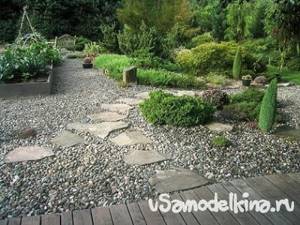
Growing grasses look impressive in the gravel. At the end of spring, they shimmer with colors, from bluish-violet to silvery white. Autumn colors the grains in bronze and purple tones. And in winter, frost-covered grasses look bizarre and mysterious. The soothing rustle of cereals creates the impression of freedom and lightness.
The list of ornamental crops for a gravel garden includes thyme, sedum, various forms of yarrow, physostegia, hostas, almost all types of wormwood, maned barley, poppies, bergenia, lunaria, plantain, euphorbia, perennial asters, kupena, tansy, feather grass, sedum, angelica , saxifrage and many others.
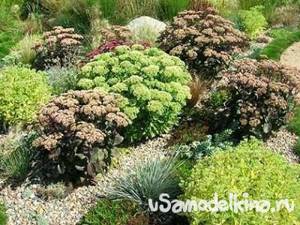
Tall flowers and herbs especially attract attention: Chinese miscanthus, Japanese anemone, gypsophila paniculata, mullein, cottonweed, tall speedwells, goldenrods, monardas.
Shrubs and trees are also used in gravel gardens. However, it should be remembered that their number should not be too large so as not to spoil the beauty of the landscape. Alternate woody and herbaceous plants, bulbs, and perennials to give the garden the look of a semi-wild, natural landscape.
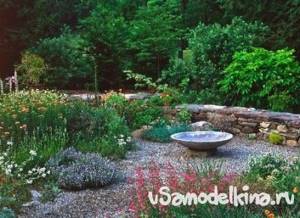
Plants should be planted in large groups evenly throughout the gravel garden. The garden changes regularly as plants grow, develop, and move each season to form new groups. To maintain a well-groomed appearance, it is necessary to remove weeds and trim off faded shoots that have lost their decorative properties.
Receive a selection of new homemade products by email. No spam, only useful ideas!
*By filling out the form you agree to the processing of personal data
Site preparation
The most optimal soil for planting a garden is sandy. It is loose, free-flowing, and allows water to pass through well. If the soil initially in the chosen location is not the same, you need to make a drainage layer. To do this, remove 10-15 cm of soil. All weeds, roots and possible debris are removed. After this, the area should be moistened and left for a week. This time is enough for the emergence of new weeds whose roots remain in the soil. If weeds do appear, they must be completely removed.
A week later, the area under the garden is dug up along with a mixture of expanded clay and coarse sand, as well as vermiculite. The last component can be replaced with expanded clay, brick or granite chips. In this way, it will be possible to create the necessary layer to remove excess moisture. If necessary, organic fertilizers (for example, peat) can be added to the soil.
Finally, the soil should be compacted slightly and covered with black geotextile, which prevents the appearance of weeds and the subsidence of the gravel layer.
Preparing the soil
First of all, you need to choose a place for a gravel garden. It's good if your site has sandy soil. If not, then you can set up a garden in a flowerbed. So, when you have decided on the location, you should mark the area. Its boundaries are marked with a rope. Then from this place you need to remove the turf and a layer of soil about 20 cm thick. Make sure that all the roots of perennial weeds are removed. The resulting pit must be moistened and left for 10 days so that the roots of weeds and plants remaining in the soil can germinate. Then they are also dug out from the site.
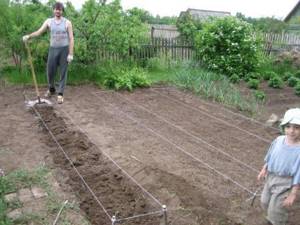
To prevent too much moisture from collecting in the area, it is best to provide drainage. To do this, the area is dug up and baking powder is added to each square meter. The raising agent mixture includes:
- expanded clay sand;
- coarse sand;
- brick chips;
- vermiculite
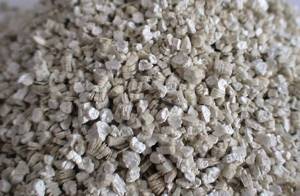
Next, the soil in the area should be compacted using a garden roller. To prevent weeds from growing in the ground, agrofibre is laid at the bottom of the pit. This may be black geotextile. Not only will it prevent weeds from growing, but it will also keep gravel from penetrating into the soil.
Backfilling the area
Laying gravel is usually done before planting plants in the garden. However, you can first plant all the crops and then backfill.
When using geotextiles, the thickness of the gravel layer is only 5-10 cm. This is quite enough to densely cover the soil with pebbles and create a beautiful platform. Without using a special cloth, the gravel layer should be significantly larger - about 25 cm. After filling the pebbles, it is recommended to thoroughly water the coating.
Dividing borders must be installed at the boundaries of the site and decorative zones. They will help prevent gravel from spilling outside the territory, and will also block the growth of other plants that are located outside the composition. Dividing borders can be made from metal, plastic, ordinary boards or bricks. True, the last two materials have a significant drawback. Wood deteriorates over time under the influence of moisture, and bricks are needed in large quantities, because the border must be dug along the entire perimeter of the area that is planned to be improved, to a depth of 20-25 cm.
Plants in a gravel garden
Planting begins with shrubs; when they begin to grow, carpet and perennial plants can be planted. Then you can plant clumps of lilies. In the place chosen for planting, remove the gravel, make a cross-shaped cut in the geotextile, and bend the material inward.
A hole of the size required for the plant is dug in the ground. Then the roots of the planted plant are carefully covered with earth.
It is recommended to water the plant a little, then put the gravel in its original place and water again.
Lastly, one- and two-year-old plants are planted, which will later be renewed through self-seeding. Seeds of annual crops are sown in early spring, and biennial ones in the first days of June, so that they bloom the following year.

Planting
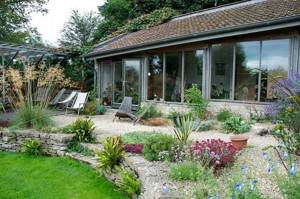
Plants for a gravel garden are planted in several stages. First of all, it is necessary to place the crops directly in containers in the places provided for in the project sketch. Thus, all the shortcomings that were made on paper can be easily corrected. For example, it may turn out that some plants do not fit well together, or they need to be placed differently. Planting begins when the owner is completely satisfied with the appearance of the gravel garden.
Trees and shrubs should be planted first. Once they have taken root, you can begin planting perennials and carpet plants. They are followed by a series of bulbous crops and flowers.
The planting technology is the same for all types:
- In the right place, the gravel layer is removed, or a hole is made in it.
- A cross-shaped cut is made in the geotextile.
- A hole of suitable size is dug.
- The plant is lowered into the hole along with a lump of earth.
- The crop is carefully dug in and the soil around is compacted.
- Finally, the plant is watered abundantly.
In order for the plants to take root, it is recommended to choose crops with a healthy root system and plant them early in the morning, in the evening or on cloudy days.
It is noteworthy that in a gravel garden, not all crops must be planted in open ground. Plants in beautiful tubs and flowerpots look no less impressive. But then care becomes a little more complicated, since such perennials need to be covered or moved for the winter. Otherwise they may freeze.
Gravel garden. Algorithm
The fashion for creating gravel gardens came to us from England.
The reference example that gave a strong impetus to the dissemination of these ideas is still Beth Shatto's garden. Since the garden imitates the natural community of a dry meadow or scree, the plants do not require frequent watering, fertile soil, or labor-intensive care. The main plants in such a composition can be cereals, drought-resistant plants and ground cover plants. Beth Chateau Garden. Photo by Andrey Lysikov
It is not advisable to occupy the entire garden with a gravel composition. Dry, well-lit areas are suitable for creating a gravel garden. On such sites it is easier to achieve the desired emotional image and select plants. It is beneficial to install gravel gardens in new areas with disturbed soil cover. Instead of serious reclamation work involving the delivery of expensive fertile soil, it is enough to ensure normal drainage.
General scheme for creating a gravel garden
1. Site selection. Assess the location of the site, its connection with other parts of the garden. Check the drainage and fertility of the soil.
2. Soil preparation. Clearing an area of weeds, especially perennial weeds, can take some time. Once weeds have been controlled, good drainage must be ensured. To do this, disintegrants are added to the soil: coarse sand, limestone (on acidic soils) or granite screenings. Depending on the mechanical composition of the soil, the application rate is 5-20 liters per m².
Materials such as brick chips, expanded clay sand, perlite and vermiculite, and charcoal optimize both air and water regimes. The use of these materials is very effective in the long term. Typically the application rate is 2-3 liters per m².
Beth Chateau Garden. Photo by Andrey Lysikov
When creating a gravel garden, you often have to solve the problem of soil fertility in an unconventional way. The fact is that the soil can contain much more nutrients than the plants need. Carbon-rich material (in the form of cellulose) is added to fix nitrogen. These are, first of all, hardwood sawdust, cut leaves, straw, even paper and cardboard. As these materials decompose, the excess nitrogen will be used by microorganisms.
You can sow a crop with a large removal of nutrients on the site, and remove the plant mass from the site during the period of maximum accumulation of nutrients. This usually coincides with the flowering phase. Sunflower and corn, fodder beets, pumpkin, and wheat are suitable for sowing.
3. Relief planning. This can be a flat surface with a slight slope of 1-3 centimeters per linear meter for water drainage or an area with more complex terrain (geoplastic) in the form of gentle dunes or a hill, but the slopes should not exceed 10°. Otherwise, it is difficult to avoid the gravel from sliding down. A mixture of stones of different sizes holds better on a slope.
Photo by Olga Bondareva
4. Backfilling with gravel. This operation begins when the “skeleton of the kindergarten” is finally formed. In the traditional version, a thick layer of river gravel, up to 20-30 cm high, is poured. To make the work easier, you can first cover the soil surface with a layer of geotextile with a density of 120 g/m. Then the soil will not mix with stones, and the gravel layer can be reduced to 5-10 cm. Geotextiles also prevent the growth of weeds.
River gravel is rounded, rounded pebbles ranging from beige to dark brown in color. Fractions of 3-10 mm and 5-20 mm are suitable for the garden. Depending on the design decision and financial capabilities, you can use sea pebbles in beautiful rich colors, stone chips with sharp edges or “tumbled pebbles” (artificially rounded pebbles), shells, broken slates (“scales” or “kopecks”), artificial materials (glass, expanded clay).
5. Planting is carried out at the final stage. First, the plants are placed directly in containers on gravel, arranged, and the most expressive solution is sought.
Then they start planting. They rake out a layer of gravel and make a funnel down to the ground. If geotextiles are used, a cross-shaped cut is made in it and the petals are folded down. They dig a hole the size of the roots, or, conversely, make a mound. Having distributed the roots, carefully sprinkle them with a layer of soil of at least 5 cm, press the soil with your hands to the roots, and carefully water the plant.
Then the gravel is returned to its place, the plant stems are straightened, and watered again. During drought, watering will be required every 1-2 weeks. In the future, the plant will receive water from nature.
6. Caring for a gravel garden comes down to trimming faded inflorescences (to prevent seeds from scattering) and cleaning up plant debris in the fall. Such gardens are beautiful even in winter if the grass stems are left until spring.
How to make... stone
In addition to what has been said, I want to share one technological trick. Sometimes you want to place a few large stones in your gravel garden or create a massive border. After all, gravel crumbles and without a solid edge can spread throughout the entire area.
There is a recipe for “artificial garden stone”, or “hypertufa”. To make it, take 1 volume part of sifted peat, 1 part cement and 1 part coarse sand or screenings (stone chips, perlite). All this is mixed well and moistened until plastic.
The surface of the artificial stone looks natural;
It can be used in the garden in different ways. To make a boulder, you can coat a piece of foam plastic or a metal barrel with the mixture. Another option is to dig a hole in the ground of a suitable shape, put a plastic garbage bag in it, fill it with the mixture, tie it tightly and shape it with your hands. After a week, remove the resulting casting, treat it with a stiff brush and wash it with a solution of potassium permanganate.
Garden decoration
Garden gravel is a unique material that allows you to experiment with color and fraction, creating unique patterns and changing the topography of the site. To create accents, you can complement the coating with inclusions of sandstone, jadeite, marble, dolomite, quartzite, diabase, shell rock, and jasper.
Natural wooden decking, which can serve not only as a decorative element, but also perform a practical function, looks very beautiful in a gravel garden. From them you can make a path passing through the composition. It would also be nice to arrange small recreation areas on such platforms.
The following can be used as decorative elements for the garden:
- garden lamps (eg stone lanterns);
- coarse gravel and boulders;
- small bodies of water;
- interesting garden sculptures.
Advice: if you plan to install lamps in a gravel garden, then you need to plan this in advance so that the necessary cables can be laid at the stage of preparing the soil. But this only applies to electric lamps. Solar powered lanterns can be placed at any time.
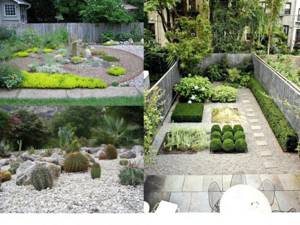
You can see the design ideas for gravel gardens in the photographs above. For example, a round flower garden looks impressive, the center of which is decorated with a small obelisk and large stones. In this case, low-growing plants “spread” from the center to the edges of the flowerbed.
Another interesting solution would be to decorate a gravel garden with cacti and succulents. True, in our latitudes these plants will not survive the winter, so they should not be dug into the ground, but placed in pots.
A simple, but no less attractive geometric design will help to significantly simplify the task of decorating a garden. To do this, it is enough to leave a few squares among the gravel cover, in which the plants will then be planted. By the way, this idea is suitable for stylish garden design.
How to choose the right plants?
Trees and shrubs
Plants are planted in groups or individually so that they stand out against the background of gravel, and do not merge with each other, in which case the garden will look much less impressive.
In a gravel garden, low-growing and dwarf trees look beautiful - weeping willow, willow, birch, rowan. The atmosphere in such a garden is greatly enlivened by vertical coniferous plants - spruce, western thuja. Needles of different shades and the pyramidal shape of conifers decorate the garden. Among the shrubs, barberries and cotoneasters are suitable; they have an interesting shape of the crown and leaves, red fruits and leaves will be especially good in the garden in the fall.
Thickets of Cossack juniper can be located near the border of the garden. Against the backdrop of gravel paths, Japanese spirea with its round shape and delicate rounded inflorescences, Arends saxifrage, which has equally elegant flowers and leaves, looks good.
Barberry bushes with blushing foliage transform the garden, making it more vibrant
Advice. For a gravel garden, it is better to choose plants with graceful leaves, shrubs and trees with an original crown shape. Pebbles or gravel will only emphasize the appearance of such plants, making the garden original and aesthetically attractive.
Herbaceous perennials
The decoration of the garden will be crocuses and alpine edelweiss, forget-me-nots, wild tulips, bright multi-colored graceful carnation flowers. In May, poppies will delight the eye.
Bushes of alpine asters, popularly known as September asters, will decorate your gravel garden in the fall.
All types of sedums (ground cover plants) make excellent gravel garden plants.
In such a decorative garden it is not necessary to plant all the plants. You can use, for example, thujas in large pots, geraniums. The same ground cover will grow well in a pot, and if you like to change the environment, tubs and pots with plants can be placed in a different place from time to time.
This garden is also decorated with plants in ceramic pots - geraniums and petunia. They bloom beautifully, and you can place the pot anywhere
One of the main rules when creating a gravel garden is that there should not be too many plants, otherwise the very original idea of creating such a garden will be lost.
Coniferous plants, trees and shrubs will help set the main accents of the garden composition, and herbs and flowering plants will complete it.
Here, only coniferous plants were used to decorate the garden. It turned out very well, and besides, such a garden is beautiful at any time of the year.
In a gravel garden, you can use wooden decking or lay out a path of large flat decorative stones or saw cuts - they are comfortable to walk on, and, in addition, they are excellent decorative elements.
A very impressive path was created using gravel, decorative wattle fence and saw cuts
All in all, creating a gravel garden is a creative endeavor that anyone can succeed at. Good luck!
diz-cafe.com
Further landscape maintenance
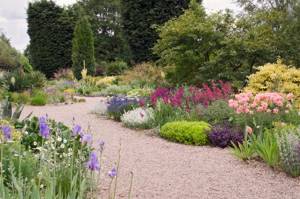
In most cases, minimal maintenance is required for a gravel garden, and it boils down to following these recommendations:
- At first, planted plants need regular soil moisture for good rooting. After the crops have taken root, watering is carried out according to their requirements, taking into account that gravel retains moisture for a long time.
- Even with full compliance with the technology for performing landscape work, weeds will appear on the site, as their seeds are carried by the wind. It is quite difficult to remove such cultures from stones. It's best to weed them out.
- Garbage can be just as much of a problem as weeds. Therefore, it must be removed in time using a rake or a stiff brush. These tools are convenient for working on dense surfaces. If the backfill is loose, it is better to remove the debris by hand.
- Once every two years, it is recommended to update the gravel surface by adding fresh pebbles.
- If necessary, you can apply fertilizer to the plants from time to time.
- Wilted crops must be removed and new ones planted in their place.
Such simple steps will help keep the gravel composition clean and maintain its spectacular appearance.
If you have not yet decided on a full-fledged stone garden, try making garden paths from gravel, decorated on the sides with unpretentious plants.
Caring for a pebble garden
Keeping a gravel area clean is not the hardest job. It is necessary to regularly remove fallen leaves and any plant debris using a rake or garden vacuum, otherwise the organic materials will decompose, creating humus - an ideal fertile soil for weeds. In the fall, you can make your task easier by stretching a mesh over the gravel fill. To prevent the appearance of moss on the pebbles, choose a sunny place to lay such a site. If plaque does appear, special equipment, which can be found in specialized stores or on the Internet, will help get rid of it.
Setting boundaries
So that the stones do not “go on a journey” to the surrounding areas, and “representatives” of different sizes and colors do not mix with each other, clearly defined boundaries are needed, especially if the gravel flower bed is adjacent to a lawn or an ordinary flower bed. A strong and durable edging will be made from paving stones laid out in a row, installed on a cushion of cement-sand mortar. A less noticeable border is obtained from metal borders, such as stainless, galvanized or dark Corten steel.
Important : you should not step on the edging made of these materials, as it bends easily. If the gravel flower bed is located on a slope, the border should be slightly higher than the adjacent lawn or path - then the stones will not spill out of the flower bed. Is the slope very steep? Divide it into several even terraces and decorate each one at your discretion.
Mulching
For a real gravel flower garden, it is not enough to simply spread stones on a non-woven material in a layer of 5-8 cm. It is much more correct to mix garden soil with gravel or crushed stone to the depth of a spade bayonet in order to provide the drought-resistant plants typical of a rock garden with ideal conditions for growth and development. Only after this, spread the non-woven material and spread the gravel on it. A layer of stones is not only decorative - it also serves as mulch: it levels out temperature changes and retains moisture in the ground. But it is the non-woven material that prevents the growth of weeds.
Selection of materials for backfill
Those who decide to create a gravel garden with their own hands will definitely face the question of purchasing the main material - gravel. Gravel enjoys well-deserved popularity in garden design - it is durable, chemically neutral and very decorative. There are small, medium and large fractions of gravel.
Not every bulk material is suitable for a gravel garden: the concept of such a landscape involves the use of those types of materials that are associated with the sun, steppe, and wind. Designers recommend leaving round stones, as if polished with water, to create Japanese, Chinese and water garden styles. Colored natural stone is appropriate in a gravel garden, including:
- pink quartzite;
- marble chips of various shades;
- granite chips of different colors;
- green coil;
- jasper, etc.
Gravel painted with special paints looks very decorative. From such material you can create spectacular backfills in the form of panels or ornaments.



